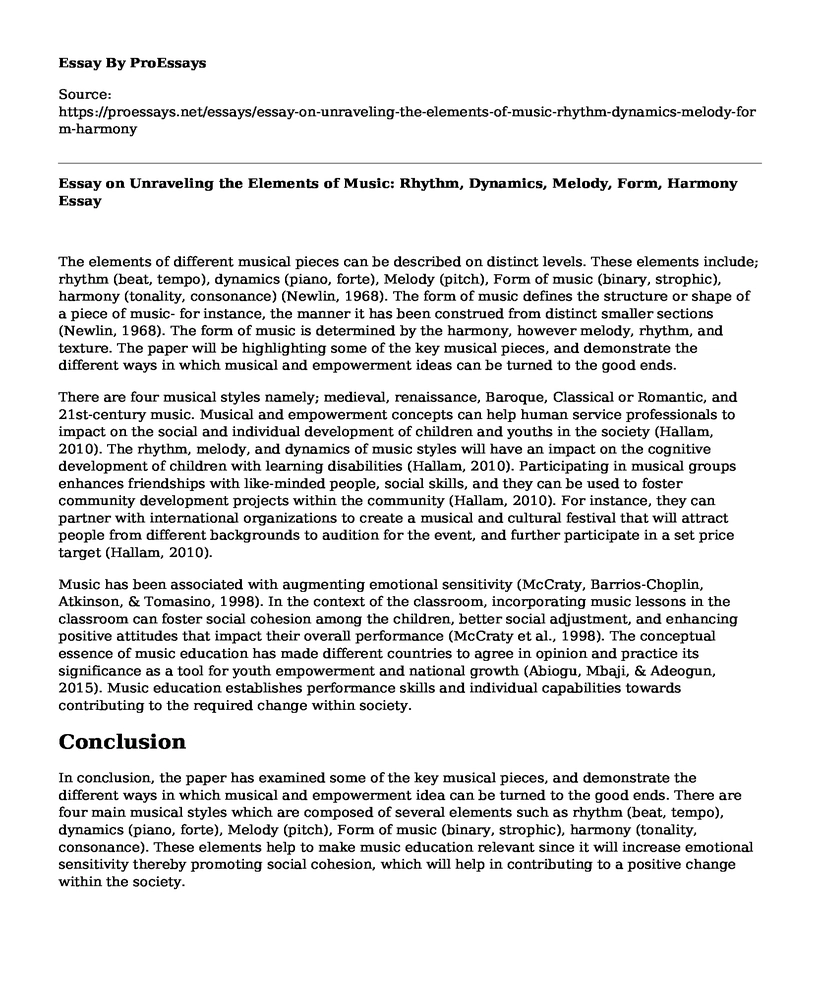The elements of different musical pieces can be described on distinct levels. These elements include; rhythm (beat, tempo), dynamics (piano, forte), Melody (pitch), Form of music (binary, strophic), harmony (tonality, consonance) (Newlin, 1968). The form of music defines the structure or shape of a piece of music- for instance, the manner it has been construed from distinct smaller sections (Newlin, 1968). The form of music is determined by the harmony, however melody, rhythm, and texture. The paper will be highlighting some of the key musical pieces, and demonstrate the different ways in which musical and empowerment ideas can be turned to the good ends.
There are four musical styles namely; medieval, renaissance, Baroque, Classical or Romantic, and 21st-century music. Musical and empowerment concepts can help human service professionals to impact on the social and individual development of children and youths in the society (Hallam, 2010). The rhythm, melody, and dynamics of music styles will have an impact on the cognitive development of children with learning disabilities (Hallam, 2010). Participating in musical groups enhances friendships with like-minded people, social skills, and they can be used to foster community development projects within the community (Hallam, 2010). For instance, they can partner with international organizations to create a musical and cultural festival that will attract people from different backgrounds to audition for the event, and further participate in a set price target (Hallam, 2010).
Music has been associated with augmenting emotional sensitivity (McCraty, Barrios-Choplin, Atkinson, & Tomasino, 1998). In the context of the classroom, incorporating music lessons in the classroom can foster social cohesion among the children, better social adjustment, and enhancing positive attitudes that impact their overall performance (McCraty et al., 1998). The conceptual essence of music education has made different countries to agree in opinion and practice its significance as a tool for youth empowerment and national growth (Abiogu, Mbaji, & Adeogun, 2015). Music education establishes performance skills and individual capabilities towards contributing to the required change within society.
Conclusion
In conclusion, the paper has examined some of the key musical pieces, and demonstrate the different ways in which musical and empowerment idea can be turned to the good ends. There are four main musical styles which are composed of several elements such as rhythm (beat, tempo), dynamics (piano, forte), Melody (pitch), Form of music (binary, strophic), harmony (tonality, consonance). These elements help to make music education relevant since it will increase emotional sensitivity thereby promoting social cohesion, which will help in contributing to a positive change within the society.
References
Abiogu, G. C., Mbaji, I. N., & Adeogun, A. O. (2015). Music Education and Youth Empowerment: A Conceptual Clarification. Retrieved from: https://www.scirp.org/pdf/OJPP_2015021211213448.pdf
Hallam, S. (2010). The power of music: Its impact on the intellectual, social and personal development of children and young people. International Journal of Music Education, 28(3), 269-289. Retrieved from: file:///C:/Users/User/Downloads/The_power_of_music_Its_impact_on_the_intellectual_.pdf
McCraty, R., Barrios-Choplin, B., Atkinson, M., & Tomasino, D. (1998). The effects of different types of music on mood, tension, and mental clarity. Alternative therapies in health and medicine, 4(1), 75-84. Retrieved from: file:///C:/Users/User/Downloads/Theeffectsofdifferenttypesofmusiconmoodtensionandmentalclarity.pdf
Newlin, D. (1968). Fundamentals of Musical Composition: By Arnold Schoenberg. Edited by Gerald Strang, with an introduction by Leonard Stein. New York: St. Martin's Press, 1967. 224pp., Illustrations, Index, Musical examples. $32.50. Music Educators Journal, 55(1), 92-93. Retrieved from: https://monoskop.org/images/d/da/Schoenberg_Arnold_Fundamentals_of_Musical_Composition_no_OCR.pdf
Cite this page
Essay on Unraveling the Elements of Music: Rhythm, Dynamics, Melody, Form, Harmony. (2023, Mar 02). Retrieved from https://proessays.net/essays/essay-on-unraveling-the-elements-of-music-rhythm-dynamics-melody-form-harmony
If you are the original author of this essay and no longer wish to have it published on the ProEssays website, please click below to request its removal:
- Paper Example on Information Sharing
- Narrative Situation of Story Paper Example
- The Songwriting of Paul McCartney in the Beatles Years Annotated Bibliography
- Research Paper on 21st Century Cinema
- Annotated Bibliography on Social Networking on Society
- Essay Example on Free Speech: David Cole's Argument for Its Defense
- Goya: A Spanish Painter of Romanticism & Court Painter - Biography Sample







